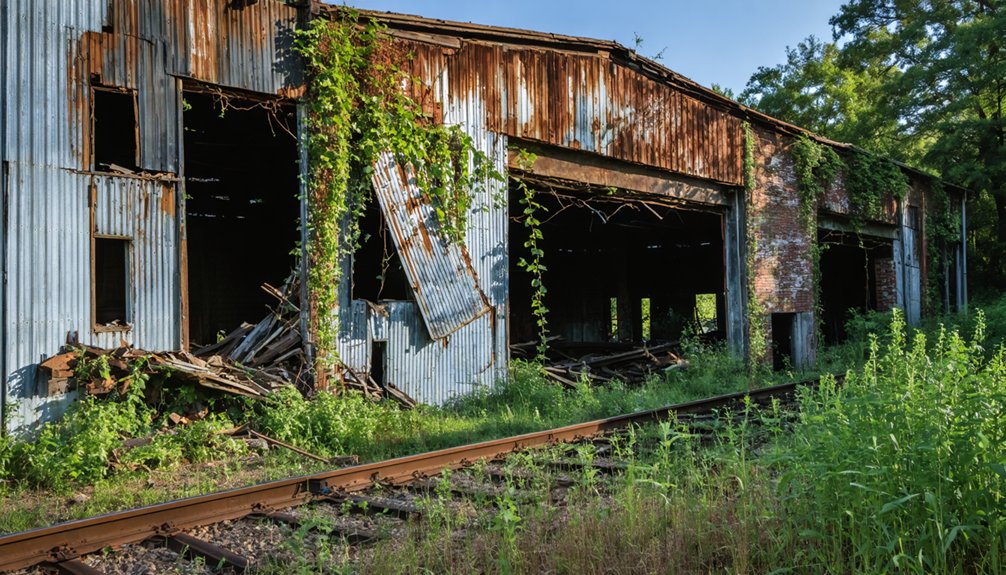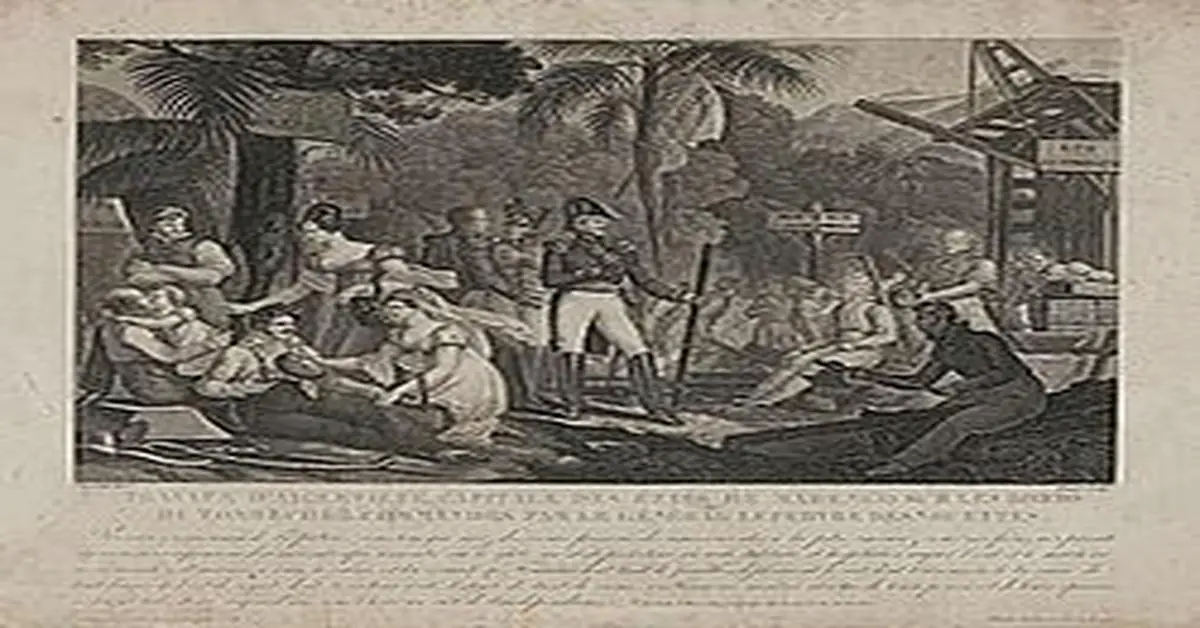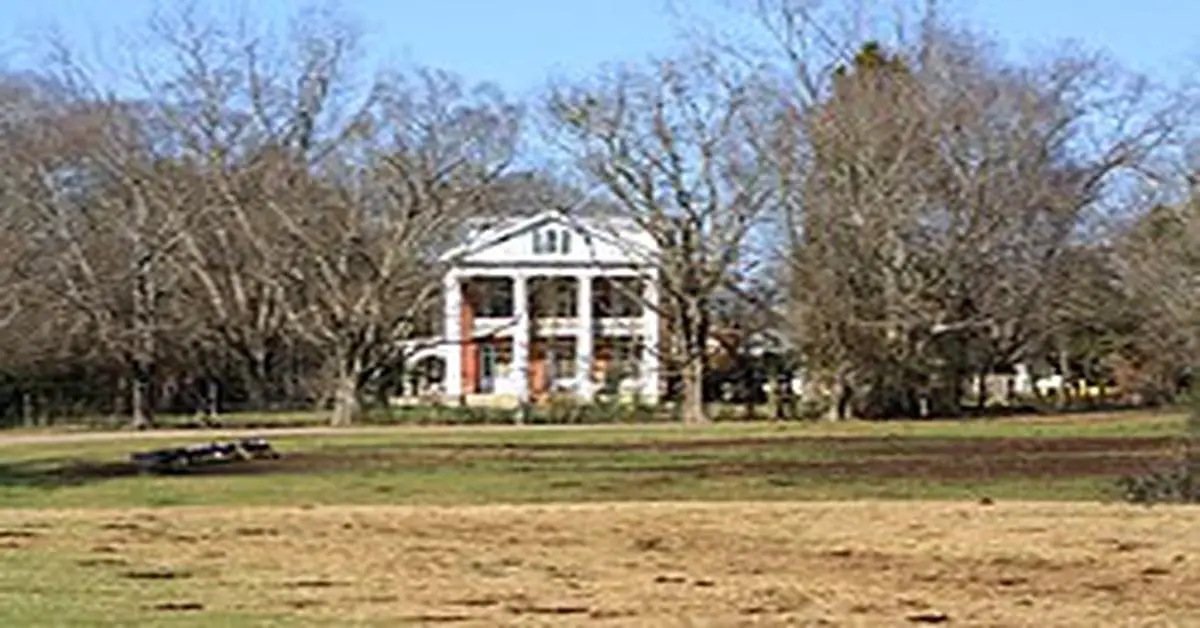You’ll find Kaulton just outside Tuscaloosa, Alabama, where the Kaul Lumber Company built a thriving mill town in 1912. At its peak, the operation produced 40 million board feet of lumber annually and featured modern worker housing, stores, and recreation facilities. The mill’s closure in 1931 triggered the town’s decline, and by the 1960s, urban renewal policies scattered the remaining residents. Today, nature has reclaimed much of this once-bustling industrial community, but its story reveals fascinating insights into Alabama’s lumber era.
Key Takeaways
- Kaulton was established in 1912 as a model lumber mill town near Tuscaloosa, Alabama, featuring worker housing and community amenities.
- The town centered around the Kaul Lumber Company’s advanced mill complex, which produced 40 million board feet annually.
- The mill’s closure in 1931 led to widespread abandonment as workers and families departed the once-thriving company town.
- Urban renewal in the 1960s displaced remaining residents and demolished historic structures, permanently altering the community.
- Nature has reclaimed the abandoned town, with thick forest growth overtaking former mill sites and deteriorating buildings.
The Birth of a Lumber Empire
When the Kaul family ventured south from Pennsylvania in 1889, they laid the foundation for what would become one of Alabama’s most significant lumber operations.
You’ll find their first major success in Hollins, Clay County, where they established a sawmill that would harvest between 80,000 to 100,000 acres of prime timber.
After a devastating fire in 1908, the Kauls didn’t just rebuild – they revolutionized.
Their lumber innovation took shape in 1912 with a bold move to Kaulton, near Tuscaloosa, where they created a larger, more advanced mill complex. The town’s distinctive palm fan layout made it a model of efficient urban planning.
In 1912, the Kauls revolutionized Southern lumber by establishing their state-of-the-art Kaulton mill near Tuscaloosa, Alabama.
They mastered timber transportation by developing over 75 miles of narrow-gauge railroad, connecting their vast timberland holdings to mills and markets.
This strategic network, paired with modern gasoline-powered sawmills, positioned them as industry leaders in the South. Like many local family operations, they maintained ownership and control of their timber resources rather than clear-cutting and moving on.
Life in the Model Industrial Town
The Kaul Lumber Company’s vision extended far beyond industrial operations – they built an entire community from the ground up.
John Lanzel Kaul, who became president of the company, established this model town near Tuscaloosa.
In 1912, you’d have found a thoughtfully designed town complete with worker housing, a company store, recreation center, and hotel. The progressive layout featured wide lots and well-constructed homes, reflecting the company’s commitment to worker welfare. The company store served as the central hub of daily life for residents.
You could’ve joined your neighbors at the local churches and clubs, shopped at the central commissary, or enjoyed the recreation center’s offerings. This wasn’t just another company town – it was a model of industrial planning that prioritized quality of life through its community amenities and housing design.
The town thrived until 1931 when the mill closed. While many buildings fell to 1960s urban renewal, some structures still stand today, preserving Kaulton’s innovative legacy.
The Kaul Lumber Company Legacy
You’ll find that the Kaul Lumber Company‘s massive mill operations in Kaulton transformed Tuscaloosa’s industrial landscape from 1912 onward.
The company’s advanced machinery and efficient management practices enabled production of up to 40 million board feet of lumber annually, making it one of Alabama’s largest lumber producers. Under Andrew Kaul’s leadership, the company was instrumental in promoting yellow pine lumber throughout northern markets. His experience settling in Alabama in 1890 helped establish the company’s strong southern presence.
As a major employer and economic driver, the mill’s presence sparked significant growth in Tuscaloosa County during the early 20th century.
Mill Operations and Management
Located near Tuscaloosa, Alabama, Kaul Lumber Company established a state-of-the-art mill in 1912 that would become one of the region’s most significant lumber operations. Under John Kaul’s leadership, the company implemented management strategies focused on operational efficiency and sustainable resource management. When John died in 1931, his son Hugh Kaul took over the business operations.
The mill’s impressive capabilities included:
- Production capacity of 40,000,000 board feet of lumber annually
- Over 75 miles of narrow-gauge railroad for efficient log transport
- Integrated turpentine extraction operations alongside lumber production
You’ll find that Kaul’s operation controlled more than 80,000 acres of timberland across Bibb, Perry, and Tuscaloosa counties, with an estimated 1,000,000,000 board feet of standing timber.
The company’s success stemmed from John Kaul’s emphasis on modernization and conservation practices, working alongside forestry pioneer Gifford Pinchot to reduce waste and guarantee long-term sustainability.
Economic Impact in Tuscaloosa
While John Kaul’s mill operations showcased technological innovation, his company’s economic footprint on Tuscaloosa proved even more significant.
You’ll find that by 1912, the establishment of Kaulton transformed the local landscape, driving unprecedented economic growth through its massive lumber production capacity and extensive railroad network. The company town spurred remarkable community development, offering workers housing, a company store, recreation facilities, and social amenities that set new standards for industrial communities in the South. The town was specifically designed as a model industrial community to support its workforce.
At its peak, Kaulton’s economic influence extended well beyond lumber production. The local post office handled more financial transactions than any single post office in America, reflecting the town’s robust commercial activity.
However, this prosperity wouldn’t last forever – the mill’s decline after the 1920s led to job losses and the eventual abandonment of this once-thriving industrial hub.
Daily Operations and Mill Work
Founded in 1912, the Kaul Lumber Company established a bustling sawmill operation that formed the heart of Kaulton’s daily activities. You’d find workers streaming into the mill each day, contributing to the region’s lumber production while the company provided essential infrastructure to support the workforce dynamics.
Like the historic Beaver Mills paper mill, Kaulton’s lumber facility played a crucial economic role in Alabama’s industrial development. The company’s all-encompassing approach to community development included:
- A fully-stocked company store where you could purchase daily necessities
- A recreation center that offered leisure activities after your shift
- Worker housing units, though often basic in quality, where you’d rest between workdays
The mill’s operations dominated life in southwestern Tuscaloosa County, with most residents depending on the lumber industry for their livelihood. The town’s commitment to worker welfare was evident through their company physician who provided healthcare services to all residents. While specific technological details aren’t well-documented, the mill maintained steady production until its eventual closure.
Community Spirit and Social Infrastructure
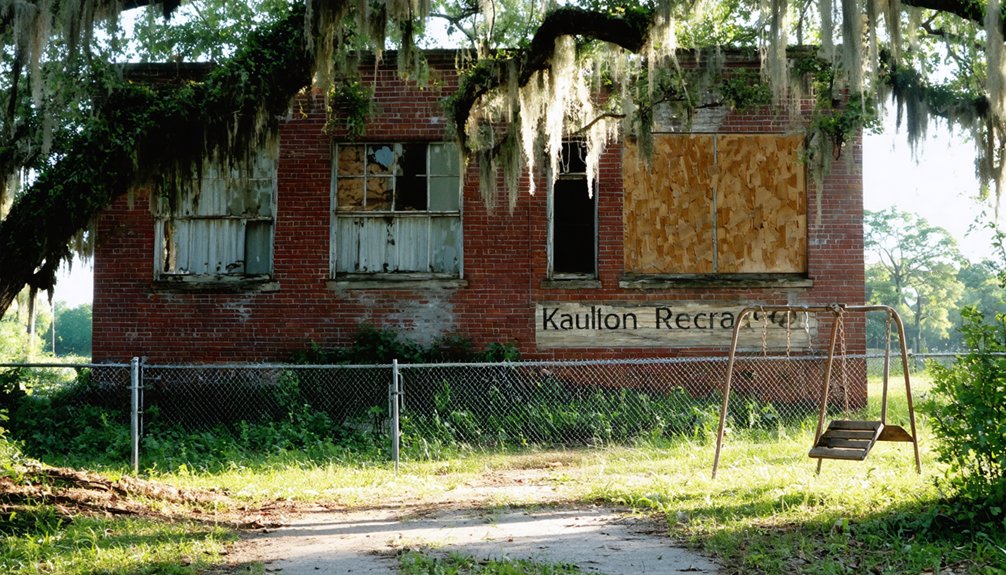
Despite its industrial origins, Kaulton emerged as a tightly-knit community where social bonds formed quickly among workers who’d relocated together from the Hollins mill in 1912.
You’d find a “model industrial town” designed to foster community gatherings and minimize worker turnover through shared amenities and spaces.
The Kaul Lumber Company provided essential infrastructure that you’d expect in any thriving town – general stores, post offices, and communal areas where residents could strengthen their social bonds.
While the company maintained control over most aspects of daily life, this centralized approach created a unique shared identity among residents.
Your position in the social hierarchy would’ve been closely tied to your role at the mill, with company-sanctioned events and activities forming the backbone of community life.
The Decline and Abandonment
As Kaulton’s timber mills ceased operations in the mid-20th century, you’d have seen workers and their families steadily departing the once-bustling company town.
You’d notice how the exodus left behind empty worker housing, shuttered company stores, and quiet streets where children once played.
The abandoned buildings, now weathered by decades of Alabama rain and heat, stand as silent reminders while nature gradually reclaims what was once a thriving mill town.
Mill Operations End
When economic conditions and shifting business strategies converged in 1931, the Kaulton mill shuttered its operations, marking the end of an era in Alabama’s lumber industry. The lumber decline was part of a broader economic shift that reshaped the region’s industrial landscape.
The Kaul Lumber Company’s evolution after the mill’s closure included:
- Maintaining substantial timberland holdings despite ceasing lumber production
- Redirecting focus to real estate and timber rights trading
- Adapting to new market conditions under fresh management
While the company maintained its land assets, it completely withdrew from active lumbering operations.
This strategic pivot reflected wider changes in the industry, including reduced demand, resource depletion, and increasing competition from other regions. The closure dealt a significant blow to local employment, forcing the community to adapt to new economic realities.
Workers Leave Town
The decline of Kaulton accelerated in the 1960s as urban renewal policies prompted mass relocation efforts.
You’d have witnessed entire families leaving their homes behind as the city began demolishing the historic “shotgun” houses and worker residences that once defined this vibrant mill town.
The urban displacement dramatically altered the community’s social fabric.
If you’d visited during this period, you’d have seen the systematic dismantling of homes and facilities that had served generations of lumber workers.
While the commissary and office buildings survived, most structures fell to the wrecking ball.
Today, these remaining buildings stand as silent witnesses to Kaulton’s industrial past, preserving community memories of a once-thriving town where lumber workers and their families built their lives around the mill.
Nature Reclaims Buildings
Through decades of neglect after the 1960s, nature steadily reclaimed Kaulton’s abandoned buildings and infrastructure.
The once-bustling lumber town succumbed to urban decay as vegetation took control, with trees and vines breaking through concrete and wooden structures.
Nature’s reclamation process transformed the industrial landscape into a haven for wildlife.
You’ll find evidence of this transformation through:
- Thick forest growth overtaking the former mill site and worker housing
- Crumbling walls and foundations being split apart by persistent root systems
- Wildlife establishing new habitats in and around deteriorating structures
Weather and time accelerated the deterioration, as rain and wind eroded what remained of the buildings.
The commissary and office buildings still stand as silent witnesses to nature’s powerful ability to reclaim human-made spaces.
What Remains Today
Modern visitors to Kaulton will find few traces of this once-bustling lumber company town, as nature has reclaimed most of the original settlement.
You’ll discover a heavily forested landscape where industrial structures and residential buildings once stood, with barely any physical remnants of the Kaul Lumber Company facilities visible today. The original road network has largely disappeared beneath natural growth.
The environmental condition of the area reflects Alabama’s humid subtropical climate, with dense forest coverage providing habitat for local wildlife.
While you might spot occasional hints of the town’s industrial past in the soil composition, nature’s resilience has transformed Kaulton into an undisturbed woodland.
Without marked trails or signage to guide you, finding specific locations requires local knowledge of this remote ghost town.
Historical Significance in Alabama Industry
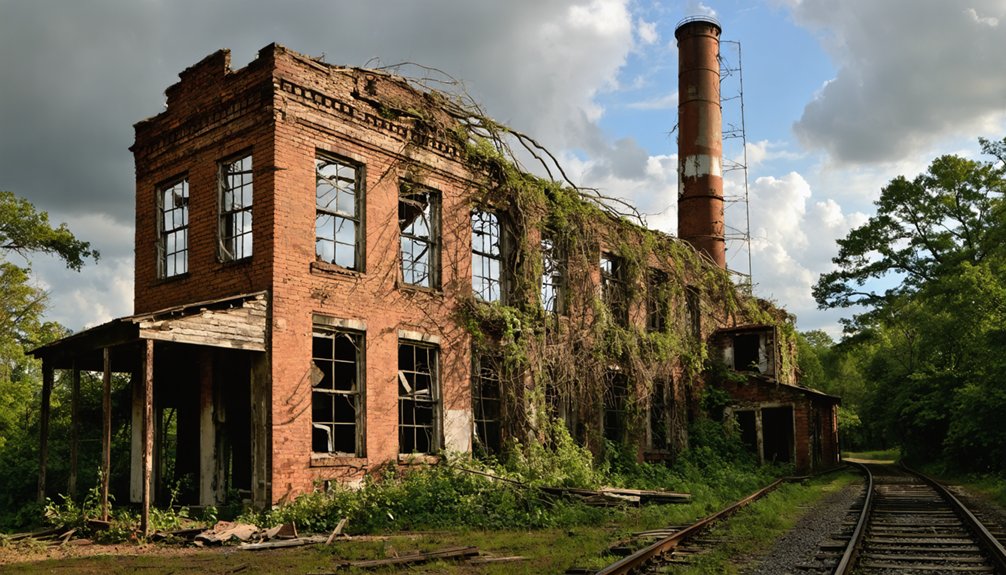
Founded in 1912 as a strategic lumber processing hub, Kaulton emerged when the Kaul Lumber Company relocated its operations from Hollins to southwestern Tuscaloosa.
This move represented a notable chapter in Alabama’s timber history, as the town exemplified the era’s industrial expansion focused on forest resources.
You’ll find Kaulton’s significance reflected in three key aspects:
- It showcased the classic company town model with worker housing, stores, and recreation facilities
- The mill provided substantial employment, driving economic growth in the Tuscaloosa region
- The operation contributed notably to Alabama’s lumber supply chain through the early 20th century
Frequently Asked Questions
Were There Any Major Accidents or Disasters at the Kaulton Lumber Mill?
Working and dying, stumbling and falling, lumber mill accidents at Kaulton claimed lives repeatedly, including a supervisor’s fatal woodchipper incident in 2023, making it their third death in 14 years.
What Happened to the Families Who Lived There After the Town Closed?
You’ll find that most families were forced into economic migration, scattering across Alabama and neighboring states in search of new jobs, while some relocated to nearby Tuscaloosa for work opportunities.
Did Kaulton Have Its Own School System for Workers’ Children?
While exact school enrollment numbers aren’t documented, you’ll find it’s likely they did have educational resources, as most company towns of that era provided schooling for workers’ families.
Are There Any Original Artifacts From Kaulton Preserved in Museums Today?
You won’t find any verified museum exhibits or preserved artifacts specifically from Kaulton in Alabama’s public collections today. Any remaining items would likely be in private hands or undocumented.
What Was the Peak Population of Kaulton During Its Most Prosperous Years?
While exact records don’t survive, you’ll find economic growth patterns suggest the peak population reached between 500-1,000 residents during the 1910s-1920s lumber boom, reflecting typical community dynamics of Southern company towns.
References
- https://inspiredsoutherner.com/haunted-history-tour-lets-you-hunt-for-ghosts-in-old-cahawba/
- https://digitalalabama.com/alabama-ghost-towns/alabama-ghost-towns/9449
- https://www.youtube.com/watch?v=hTe8F-_3-hY
- https://www.onlyinyourstate.com/trip-ideas/alabama/ghost-towns-road-trip-al
- https://www.youtube.com/watch?v=0jf3U9lIOhI
- https://en.wikipedia.org/wiki/Kaulton
- https://en.wikipedia.org/wiki/List_of_ghost_towns_in_Alabama
- https://kids.kiddle.co/List_of_ghost_towns_in_Alabama
- https://alabamaclaycounty.com/wp-content/uploads/2013/05/A-HISTORIC-OVERVIEW-OF-THE-FORESTRY-INDUSTRY-IN-CLAY-COUNTY.pdf
- https://encyclopediaofalabama.org/article/forest-products-industry-in-alabama/
